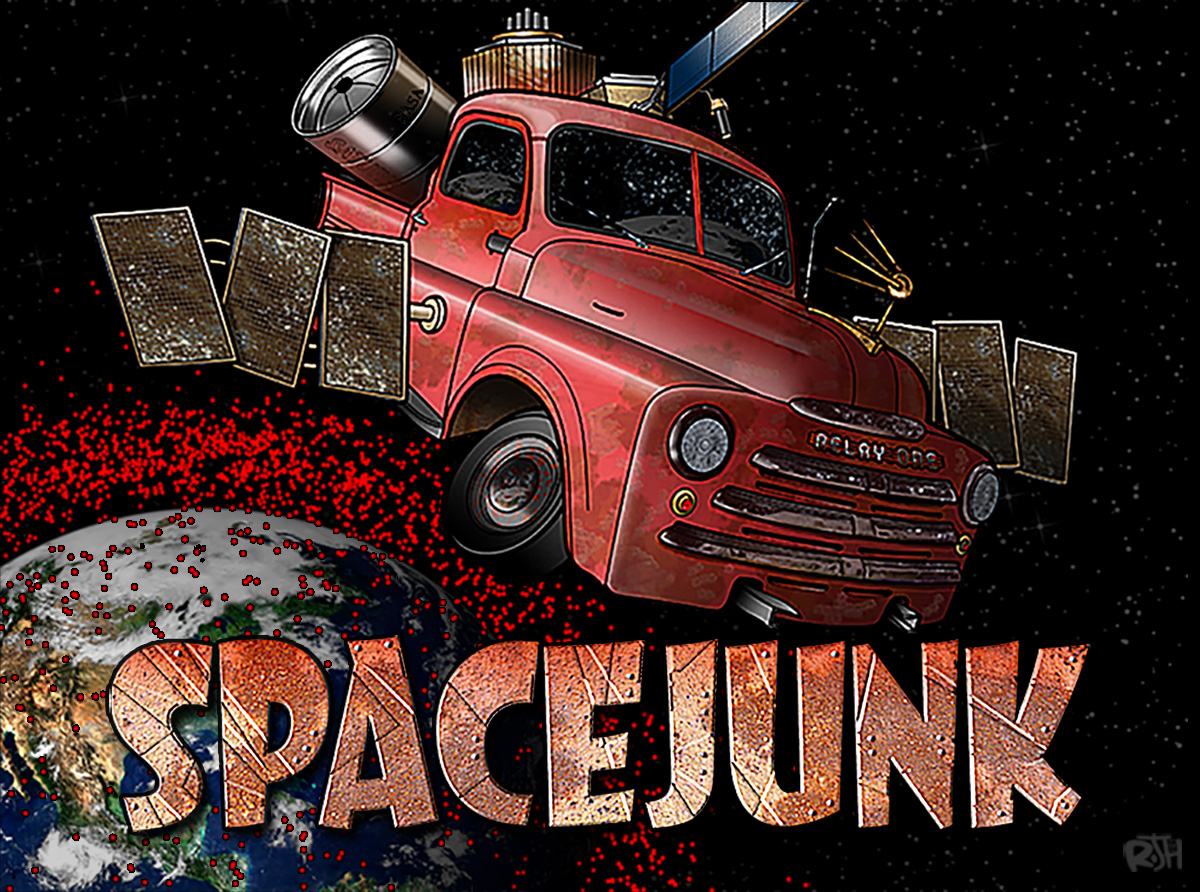
Updated: Date
Published: December 2012
It’s crowded and dangerous in space
A catastrophe waiting to happen which could destroy our way of life
By DAPHNE LAVERS
Writing from Toronto
It’s crowded in space and getting more crowded every year. Operational satellites and humans orbiting Earth in space vehicles face an increasing possibility of getting hit or even destroyed in collisions with space junk.
The debris cloud is three-dimensional, totally surrounding our home planet: a massive junkyard encircling Earth. It poses a danger to everything in orbit, including the International Space Station, broadcasting and communications satellites, as well as the Global Positioning System, all critical components of daily activities and scientific research. The junk also threatens anything trying to get into orbit and everything travelling past Earth’s orbit en route to other parts of our galaxy or universe. To summarize: it’s dangerous up there.
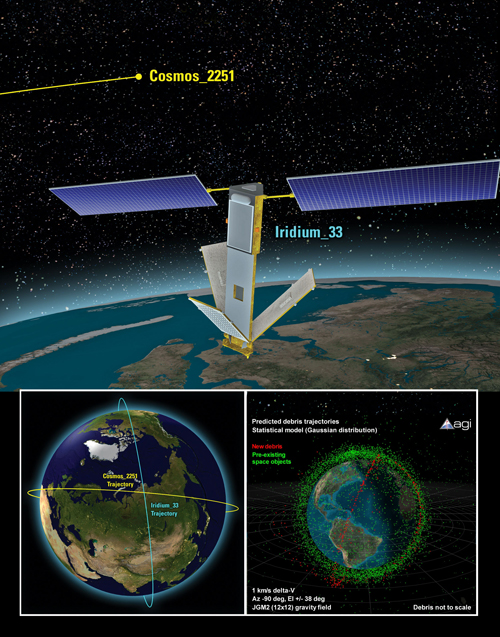
In fact, catastrophic collisions and explosions have already happened. On February 10, 2009, an American Iridium 33 communications satellite collided above Siberia with a defunct Russian military Kosmos 2251 satellite at an orbital altitude of 776 km at a relative speed of 11.7 km/second, according to records kept by the European Space Agency (ESA).1 Both satellites were destroyed on impact; communications traffic through that Iridium satellite ended abruptly at that moment.
One astonishing satellite explosion — astonishing because it was intentional — occurred in 2007. China decided to test a new anti-satellite weapon and chose as its target one of its own weather satellites.2 The new anti-satellite weapon worked; China destroyed its own Fengyun-1C weather satellite in orbit. Besides proving to the world that it could, at will, destroy orbiting satellites and spacecraft, China’s successful weapons test and subsequent explosion was recognized, and is now labelled, as the worst contribution ever to the increasing debris cloud.
These two explosions, according to the U.S. National Aeronautics and Space Administration (NASA), created one-third of all orbital debris currently tracked and catalogued.3 As satellite launches have increased, space scientists have become increasingly concerned with this expanding orbital junkyard.
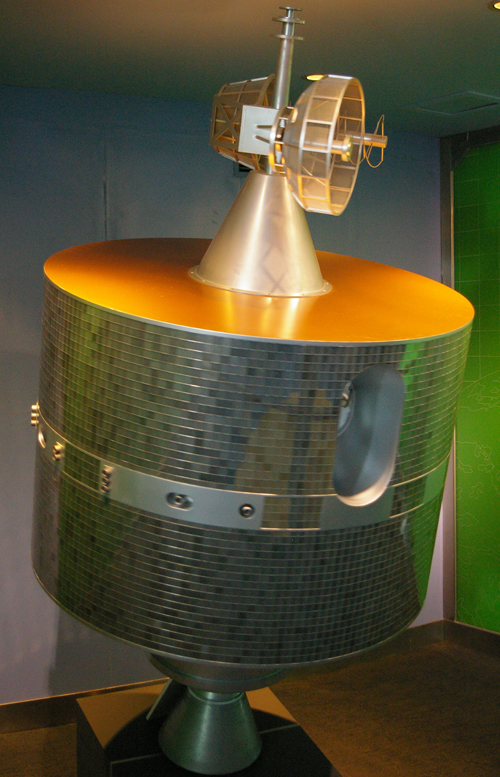
In fact, debris from the Iridium 33, Kosmos 2251 and the Fengyun-1C satellites was still falling back into Earth’s atmosphere as of December 2012.
At the end of September 2012, scientists tracked a defunct Russian satellite and the remains of an Indian rocket heading on a collision course with the International Space Station (ISS).4 Six astronauts were on board the station, travelling about 200 miles above the Earth’s surface in Low Earth Orbit (LEO). NASA went on alert, the astronauts were warned and got ready to scramble into a docked Russian Soyuz space capsule, a possible escape hatch in the event of disaster. The space junk — known as “orbital debris” — came uncomfortably close to the station. This time, it missed.
North Korea’s nasty surpriseOn December 12, 2012, North Korea launched a long-range Unha-3 three-stage rocket, reportedly carrying a payload of a weather satellite called the Kwangmyongsong 3. The rocket was launched from North Korea’s Sohae Satellite Launch Station on the nation's northwest coast.
According to news reports quoting the North American Aerospace Defense Command (NORAD), the Unha-3 rocket's first stage fell into the Yellow Sea, while the second stage fell into the Philippine Sea, missing populated areas. Three previous attempts by North Korea to launch a rocket failed, one spectacularly when it crashed shortly after launch in April 2012.
North Korea has said its new satellite is intended to observe weather, agriculture and crops on Earth. But there are curious elements in the orbit and operation of the satellite suggesting that is not necessarily its true purpose. Western observers immediately called the North Korean launch a test of a rocket system capable of carrying intercontinental ballistic missiles, targeting various areas of Earth.
Kwangmyongsong 3 was launched into Low Earth Orbit, between 300 and 365 miles above the surface of Earth. That’s somewhat higher than the International Space Station’s orbit. But the North Koreans placed the satellite into a roughly polar orbit with an inclination of 97 degrees. An exact polar orbit is on a 90 degree angle from the equator, so Kwangmyongsong’s orbit — deliberate or unwitting — is slightly elliptical. It circles the Earth (which rotates on its polar axis) from north to south every 95 minutes. That means the satellite scans the entire Earth top to bottom about 15 times per day — and it’s not focused on North Korea. It sees the entire world.
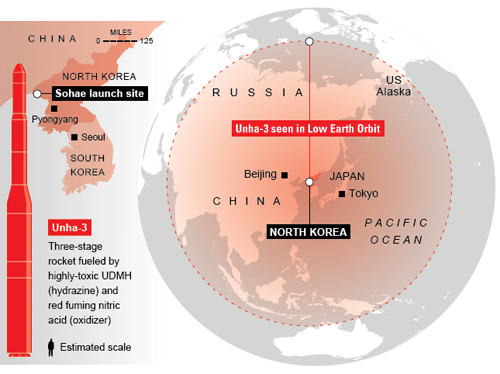
By December 13, 2012, one day after its launch, space observers were saying that the North Korean satellite was tumbling out of control and that it had the potential to crash into other satellites in Low Earth Orbit, which could prove disastrous for those satellites.
The unstable North Korean launch is an example of how the massive — one might even say astronomical — amount of junk orbiting our planet continues to increase every year. Think of the North Pacific Gyre, a.k.a. the Great Pacific Garbage Patch, one of the largest garbage dumps on the face of the Earth. The gyre is a gigantic swirling mass of garbage in the north Pacific Ocean which traps boats over an area of 7 million to 9 million square miles and up to 100 feet deep.5 The debris cloud surrounding our entire planet is like that, but exponentially larger.
Scientists are alarmedWith the end of NASA’s Space Shuttle Program and the retirement of the shuttle fleet, new private enterprises are launching commercial spacecraft to the International Space Station. Together with the looming potential of space tourism, this means that the flotsam and jetsam in orbit is receiving renewed scientific and mainstream attention because of the danger it presents to spacecraft and satellites.
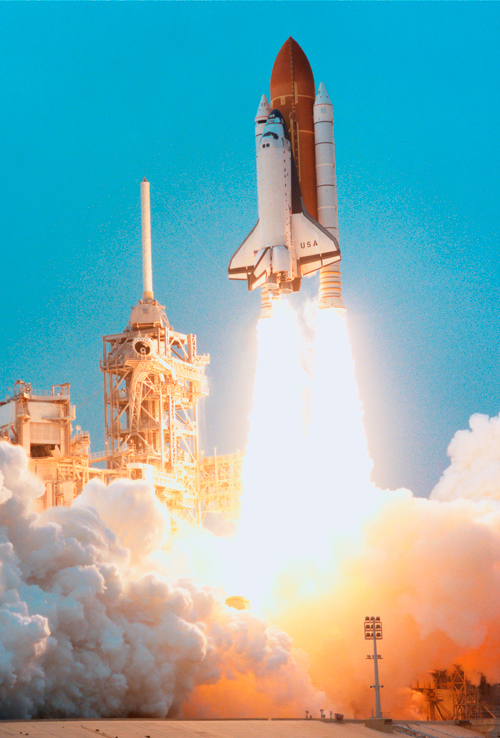
There are approximately 1,000 to 1,100 operational satellites in orbit around Earth, according to Nicholas Johnson, head of the NASA Orbital Debris Program. It’s a difficult number to confirm because many nations don’t report their satellite launches, for either national security or proprietary reasons.
Since the launch of the Russian satellite Sputnik on October 4, 1957, marking the beginning of the Space Age, there have been thousands of launches into orbit. NASA statistics estimate about 4,500 known launches of vehicles and satellites into space. Numbers compiled by ESA show 4,800 launches of 6,000 satellites.6
A large number of the spacecraft and satellites launched over the last half century are, more or less, gone — destroyed in orbit, decommissioned and left to drift, re-entered Earth’s atmosphere and partially or totally burned up, or moved to higher parking orbits.
The remains comprise a massive cloud of space debris studied by scientists and tracked by organizations around the world, including NASA:
- 21,000 pieces of tracked space junk are four inches (about 10 cm) in diameter or larger. At the smaller end, this is about the size of a baseball; the “larger” category can include such pieces as an entire defunct satellite weighing thousands of pounds.
- 500,000 pieces of debris are one to four inches in diameter (one to 10 cm), ranging in size from a marble to a baseball.
- More than 100 million particles are smaller than half an inch (one cm) in diameter. But even a one cm particle can — at the very least — tear a hole through the fragile solar wings of the International Space Station and can puncture other satellites.7
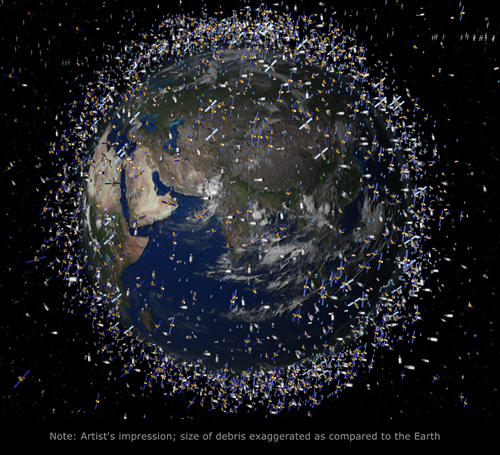
Now consider the fact that International Space Station, the largest target up there, travels at an orbital velocity of 17,500 miles or 28,000 kilometres an hour.8 At that speed, colliding with anything travelling at virtually any orbital velocity results in damage, and colliding with something big can spell catastrophe.
Disaster: a long time comingScientists have been aware for decades of the looming potential for disaster posed by collisions with such space debris. In the 1990s, I worked as Communications Officer for the Institute for Space and Terrestrial Science, a research centre based in Toronto reporting on scientific research and experiments, including the work of astrophysicists decoding images from the Hubble Space Telescope and the research of Dr. Rod C. Tennyson, one of the leading space debris scientists in Canada and an accredited NASA experimenter. Tennyson, who happens to be my spouse, is a professor emeritus at the University of Toronto Institute for Aerospace Studies (UTIAS).
I was privileged to accompany Tennyson and his research team on several visits to NASA facilities, including the Johnson Space Center in the 1990s where he conducted hypervelocity impact tests, firing projectiles at 6.6 km/second on test sections simulating Canada’s Canadarm. The test sections were manufactured of carbon fibre composite laminate, the same material used in the orbiting Canadarm, which is the Shuttle Remote Manipulator System.
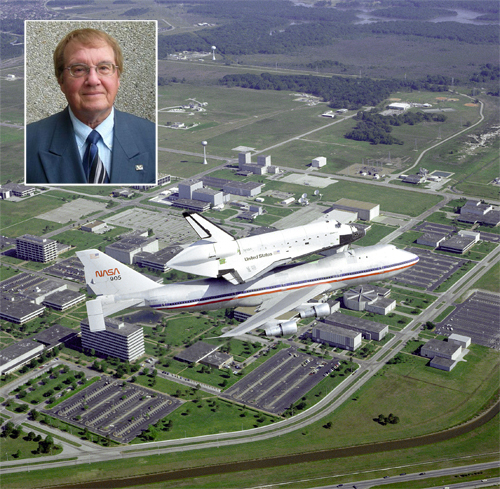
The hypervelocity impact gun at the Johnson Space Center was also used to fire projectiles at aluminium test plates, representative of other kinds of spacecraft and satellites. Tennyson was in his second term as Director of UTIAS in 1993 when those tests were conducted to determine the potential danger to satellites and spacecraft posed by collisions with space debris.
The results, published in Tennyson’s 1993 scientific paper Micrometeoroid and Orbital Debris: Impact Damage on Materials and Structures in Space, were eye-opening.9 Metal spheres of less than half an inch in diameter (9 mm projectiles) fired at the composite Canadarm sections at 6.6 km/second blew right through the outer surface, leaving readily visible entry holes and enormous fracture damage on the back side of the cylinder.

The impact created its own debris plume inside the tubular Canadarm test section, as the backside surface of the test section blew apart. The debris plume inside the test section expanded at high velocity and hit the far inside wall with a shotgun effect. Some of that debris actually went right through that back wall.
The amount of damage was sufficient to cause serious structural damage to the Canadarm test model. Such a hit could render inoperable the real Canadarm, which is the robotic, mechanical extension mounted on the Space Shuttle and is used to manoeuvre various components of the International Space Station, including satellites and other devices.
Tennyson also analyzed at the same facility, for materials comparison research, the results of other scientists’ experiments using the impact gun to fire projectiles at half-inch-thick aluminium plates. The results were just as dramatic, resulting in large craters of vaporized melted aluminium or shattered particles with a highly-damaging debris plume behind the crater hit.
Orbital debris and micrometeoroids, which are particles of less than a few millimetres in diameter originating naturally from planetary or asteroidal collisions and cometary ejecta, pose “major threats to the integrity and operational performance of spacecraft” in LEO, Tennyson stated in his paper’s introduction. LEO orbits range between 80 km and 2,000 km (between 50 miles and 1,243 miles) above Earth’s surface.
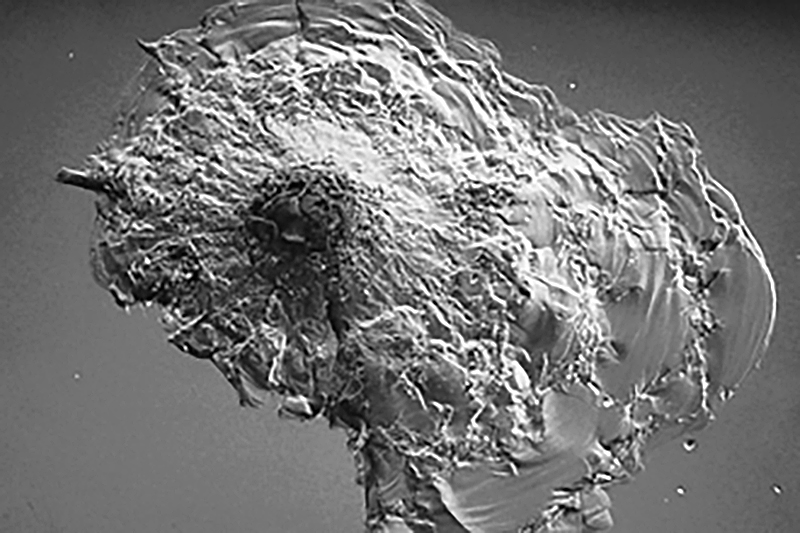
Micrometeoroids, a relatively small but significant part of the space environment, travel in various orbits at an average speed of 20 km/second, but they can reach speeds of 70 km/second.
(There are about 11 major meteor showers each year. The Perseids and the Leonids, for example, provide stunning nighttime shows of meteor streaks across the sky. The Perseid shower in August 2012 saw at its peak about 50 meteors per hour. The greatest meteor displays in the last century occurred in November 1966, when the Leonid shower produced thousands of meteors per minute over a 15-minute peak.)10

In his paper, Tennyson emphasized that the “greatest danger” to satellites and space vehicles “arises from the growing debris environment, especially as the collision or breakup of satellites, either accidental or deliberate, have produced thousands of particles ranging in size from a few millimetres to several centimetres and larger.”
Orbital debris is defined as consisting of everything from defunct satellites and spent rocket stages to aluminium oxide fuel particles, paint chips and fragmentation objects arising from collisions between bodies in orbit. Their terrestrial orbits can last from a few minutes for sub-orbital fuel particles and initial rocket stages to millions of years for geosynchronous payloads. The average velocity for debris in LEO is about 7.5 km/second.
Hubble hobbled by hitsTennyson’s paper cited stark examples of impact hits and damage on both the Space Shuttle and the Hubble Space Telescope. Between 1981 and 1998, about 70 shuttle windows had to be replaced because of impact damage. When the Hubble Space Telescope was examined in 1997, it had about 790 impacts covering 97 per cent of its area, with over 500 of the impacts on its aft shroud and equipment section, his paper stated. Most of these impacts were less than 0.8 cm in diameter.
A subsequent examination reported in the NASA Orbital Debris Quarterly News on April 12, 1999 showed that the density of hits had increased to approximately 20 impacts per square meter from five when Tennyson’s paper was written six years earlier.
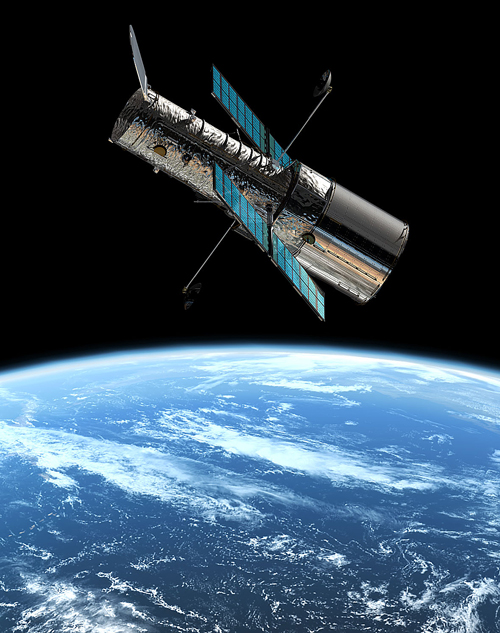
Another of Tennyson’s scientific papers was published at a small conference in Darmstadt, Germany, in April 1993 in an unprepossessing little six-page paper with four of the six pages taken up by charts and not much text. This paper, which later became known colloquially in the space community as the Chaos Nomogram, defined the possibility — moving towards the probability — that within as little as 30 to 50 years any future spacecraft or satellite launched from Earth could be destroyed in a collision with space junk before reaching orbit.
Such a scenario would create chaos on a planet already dependent on satellite communications for essential operations on the ground and in airspace. The paper and its construct weren’t called the Chaos Nomogram at the time. Hardly a sufficiently scientific moniker, that would come later as its colloquial reference. The conference paper was titled Model for Predicting Micrometeoroid/Debris Impacts and Damage to Composite Materials.11
A nomogram is scientifically defined as “a graphical presentation of relations between quantities whereby the value of one may be found by simple geometrical construction (e.g. drawing a straight line) from those of others.” In other words, the nomogram Tennyson’s research led to was a straight but rising line between the amount of space debris and the increase in damage to spacecraft and satellites
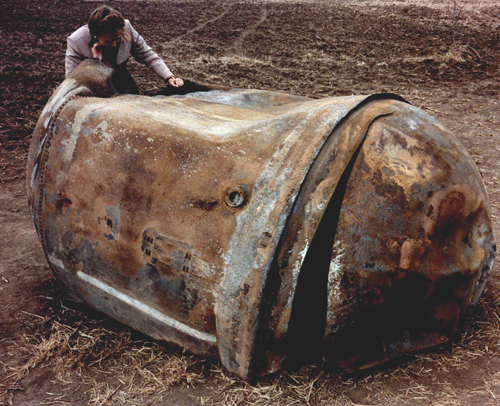
The paper presented a mathematical prediction whose impact — no pun intended — may in the next 20 to 30 years reverse the advance of space and communications technology in the 21st century.
Like much good science, Tennyson’s nomogram seems simple. It’s axiomatic on planet Earth, with our gravity, that what goes up, at least to a certain orbital altitude, must come down. Tennyson’s paper shows the large number of impacts that a satellite in LEO will encounter, with the probability of a “critical threat” impact as the debris cloud around Earth grows rapidly over time.
The science is called probability theory and the risk factor is as follows: For a reasonable-sized satellite of, for example, 20 square meters (slightly less than 20 square yards), in LEO orbit over a 10-year lifespan, the chances of a critical impact on that satellite of an object 5 mm in diameter — about a quarter of an inch — is about one in five or 20 per cent. If the debris cloud around Earth doubles in density over, for example, the next 20 years, the chance of being hit doubles to about 40 per cent.
Tennyson’s impact experiments at Johnson Space Center in the 1990s were a continuation of his earlier research into space debris, such as that conducted at NASA’s Long Duration Exposure Facility (LDEF).
In April 1984, NASA launched LDEF, a 22,000 pound spacecraft packed with samples and materials exposed to space. LDEF was designed to measure the effects of space on different materials and on spacecraft in orbit. To this day, LDEF remains a primary reference for space debris research and specifics. Tennyson was the only Canadian researcher accredited on the LDEF experiment.
LDEF orbited for almost six years until it was retrieved in January 1990. It was stationed in LEO — 200 miles or about 350 km — above the Earth’s surface, the same orbit as the International Space Station and the Hubble Space Telescope.
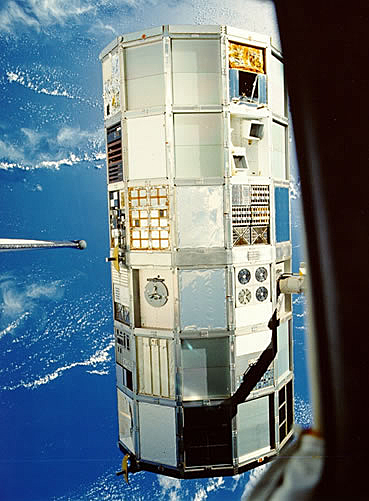
The NASA Special Investigations Group, of which Tennyson was a part, “identified and documented over 34,000 impact sites on the surfaces of the satellite, including over 25,000 impacts on the experiments’ surfaces. The features (of impact sites) ranged from a 5.25 mm diameter crater to sites only tens of microns in size.”.12
Tennyson’s LDEF experiments focused on both space debris impacts and on a variety of polymer composite materials used in spacecraft and satellites, including graphite reinforced epoxy (GRE), aramid fibre-reinforced epoxy, (Kevlar), and Kapton, the material used for solar arrays. “The retrieval of the LDEF satellite provided researchers with a wealth of information on the long-term effects of the space environment” he confirmed in his 1994 report to the Canadian Space Agency.
Brutal beating in spaceFour years later, in a lecture at the University of Toronto, Tennyson said: “When this (LDEF) satellite was retrieved six years later, all that was left of the Kapton was the adhesive — the whole sheet was gone, probably within the first 40 hours (in orbit).” Atomic oxygen particles, naturally occurring in space and also a subject of significant study, pitted and ate through about four to five layers of composite materials after five years.13
The International Space Station was at that time in its early design phase and it was thought that a number of its critical components would be constructed of those carbon fiber composite materials, including the truss structures connecting all the component modules, as well as the connecting structures to the solar arrays which power ISS.
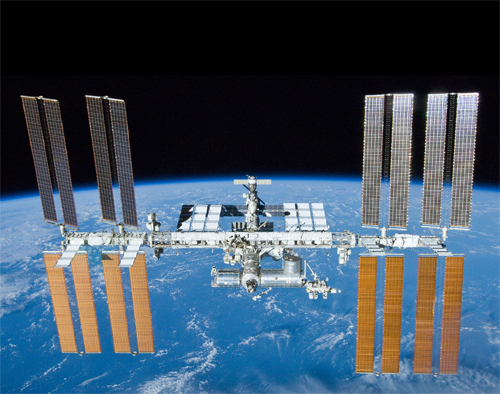
“Space Station is designed for about 30 years, so basically if Space Station had been made of these composite materials, the whole structure could have disappeared in 30 years,” Tennyson said. As a result, NASA redesigned the truss structures and connecting links in aluminium, rather than using the composites.
Before LDEF and long before construction of the International Space Station which launched its first component in 1998, the problem of space junk was clearly evident. Scientists were working on calculations and predictions as far back as the 1970s.
In 1978, NASA scientist Donald J. Kessler and Burton G. Cour-Palais published Collision Frequency of Artificial Satellites: The Creation of a Debris Belt in the Journal of Geophysical Research.14 Kessler is often quoted from the abstract of his paper:
As the number of artificial satellites in Earth orbit increases, the probability of collisions between satellites also increases. Satellite collisions would produce orbiting fragments, each of which would increase the probability of further collisions, leading to the growth of a belt of debris around the Earth.
This became known as the “cascade effect” — the exponential multiplication of space junk. In the main section of his paper, Kessler determined potential time frames for the development of this debris belt and examined some of the possible consequences of “continued unrestrained launch activities.” He predicted conservatively that the first major satellite collision would occur around 1997. In fact, by the time his theory was proved by the first catastrophic collision in 2009 between the American Iridium and the Russian Kosmos satellites, Kessler had retired.
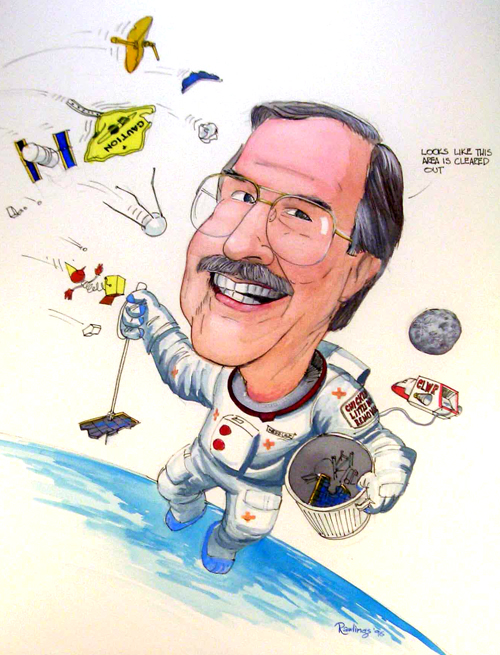
His paper described the effects of an average impact speed of 10 km/second which would subject both objects to “very high instantaneous pressures…the strong shock waves causing melting and possible vaporization in the immediate region of the impact. A crater, or hole, will be formed, the molten ejected mass coalescing into more or less spherical particles,”15 pretty much what Tennyson’s impact experiments and analysis proved.
Kessler predicted doomProjections of space debris were calculated to the years 1990, 2020 and 2100: Kessler predicted that even if all launch activity ceased in 2020, even if a similar object was returned to Earth for every object sent into orbit, and even if unused objects were forced into atmosphere re-entry, the amount of space debris would continue to increase.
“Only a few…removal mechanisms exist for Earth-orbiting satellites. They are basically only retrieval and atmospheric re-entry.” The evolution of the debris belt around the planet, Kessler concluded, “could be a ring system, similar to that around Saturn and Uranus….”16 But in the case of Earth, the ring would be composed of space junk!
Kessler’s predictions were confirmed and reconfirmed. By 1999, space research scientists calculated that within the following 10 to 20 years, any spacecraft launched from the surface of the planet had a very real risk of collision en route to orbit.17
The Cambridge-based Union of Concerned Scientists (UCS) operates the UCS Satellite Database which pegs the public number of known operational satellites at 1,016 as of July, 2012. That includes, according to their database, 443 U.S. satellites, 110 Russian satellites and 120 Chinese satellites.18
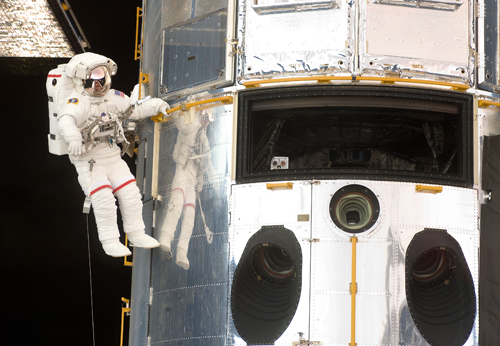
The International Space Station, the largest Earth-made object in space, orbits in LEO, about 350 km (200 miles) above the Earth’s surface. It is the biggest — albeit unintentional — target, measuring 357 feet (about 38 meters) end to end, about the size of a football field, and weighing about 925,000 pounds (465,000 kilograms). Its speed — orbital velocity — as it circles Earth 16 times a day is 17,500 miles/hour (about 28,000 km/hour).19 The key point to note is that space debris and satellites travel at different speeds in different orbits, so impact — with the International Space Station, for example — could be explosive.
The Hubble Space Telescope is also in LEO orbit, which was the approximate altitude range of the former Space Shuttle Program. Since the end of the shuttle program, new private commercial space flight vehicles now launch to that orbit to resupply the International Space Station.
LEO orbit is convenient because it’s accessible from Earth, should components need to be fixed or delivered to those spacecraft. According to the UCS Satellite Database, there are about 489 satellites in LEO orbit.
GPS is jeopardizedThe orbit critical to Earth-based navigation communications is Medium Earth Orbit (MEO), which ranges between 2,000 km and 35,200 km altitude (about 1,243 miles to 21,872 miles above Earth). MEO is where Global Positioning System (GPS) satellites are located in a variety of orbits circling Earth twice a day. The GPS, considered an international utility like electricity or water, is now crucial to 21st century timing and navigation of all kinds — from civilian aircraft to trucking fleets, and from backcountry mountain climbers to the family minivan and military operations. Among the most recent proposed uses of GPS is the testing in California of Google’s “driverless cars,” which rely on the GPS to get from Point A to Point B without the intervention of a human driver.
The UCS Satellite Database notes there are 68 satellites in MEO. The U.S. Air Force manages the American Global Positioning Satellite constellation of about 27 satellites. Three to four inactive satellites ensure redundancy; they can be activated if necessary to ensure the system maintains its accuracy.20 Russia has a counterpart GPS system called Global Navigation Satellite System (GLONASS), designed for 21 operational satellites and three spares in an orbit slightly below the American GPS satellites, at about 19,100 km above Earth.21
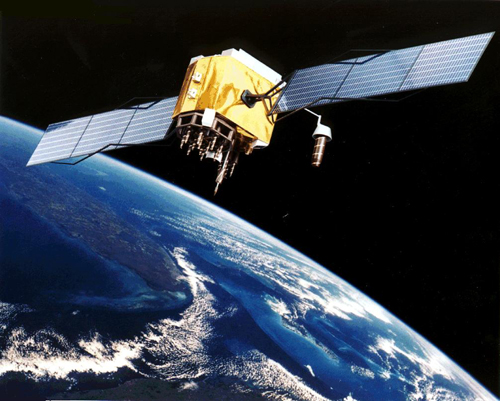
“The satellites in the (U.S.) GPS constellation are arranged into six equally-spaced orbital planes surrounding the Earth, each containing four ‘slots’ occupied by baseline satellites,” says the UCS website. “This 24-slot arrangement ensures there are at least four satellites in view from virtually any point on the planet.”22 That four-satellite pinpointing is how this satellite constellation can accurately determine virtually any location on the planet.
The most useful and coveted orbit for communications and broadcasting satellites is the much higher and more crowded Geostationary Orbit (GEO). The GEO orbit is located around the equator at about 35,786 km (22,236 miles) above the Earth’s surface.
In GEO orbit, a satellite travels at the same speed as Earth and at the same rotation, so the satellite appears to remain stationary relative to a position on Earth. This means that ground-based satellite dishes pointed at that satellite are fixed; they don’t have to move or track the satellite across the sky. So television viewers who get their TV signals by satellite can install their receiver dishes in a permanent location and lock onto the satellite signal. And because the GEO satellites orbit at such a high altitude, they are capable of covering about one-third of the Earth’s surface; for example, North and South America. That’s a significant benefit to television broadcasters.
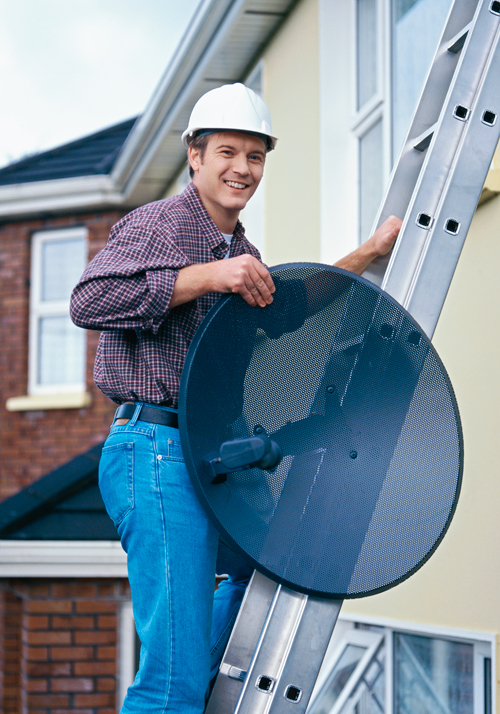
UCS notes 424 satellites in this orbit, which includes Telesat Canada’s Anik-series multi-frequency broadcasting satellites and its direct-to-home Nimiq television satellites, used by Bell Satellite TV services (formerly Bell ExpressVu) in Canada. Its Nimiq 6 satellite was launched on May 18, 2012 from the Baikonur Cosmodrome in Kazakhstan.
The International Space Station in LEO orbit, all the broadcasting and communications satellites in GEO orbit and now the worldwide GPS system in MEO orbit have become critical to a myriad of activities and operations on Earth. Space debris puts all of this in jeopardy.
Scramble for your lifeSpacecraft regularly get hit by space junk, and the September incident with the International Space Station was certainly not the first serious near hit or miss. In March 2012, the crew of the International Space Station faced a possible collision with debris which had scattered across the cosmos from the 2009 collision of the Russian Kosmos 2251 and the American Iridium 33 spacecraft.23 The crew was actually directed to scramble off the main section of the station into a docked Soyuz space capsule.
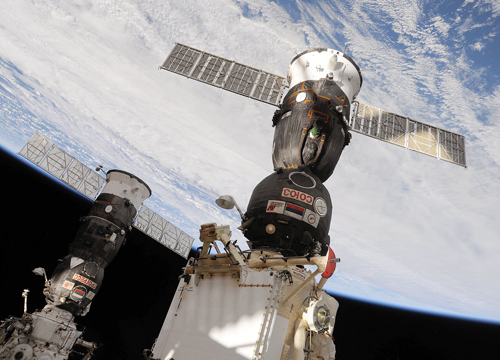
Just nine months earlier, the same thing happened. In June 2011, the station crew scrambled into another docked Soyuz space capsule, this time to avoid debris from a Proton rocket engine. The space junk came within 850 feet of the space station — more than too close for comfort.24
Fortunately, the Russian Soyuz space capsule serves as a crew return vehicle in the event of an emergency on ISS, or as a safe haven in the event of a space debris collision. Since the termination of the Space Shuttle Program, Russia’s Soyuz has been, until the 2012 advent of private commercial launches, the spacecraft astronauts depended upon to return to Earth. Launched from the Baikonur Cosmodrome in Kazakhstan, each Soyuz consists of an orbital module, a descent module and an instrumentation/propulsion module with a guidance navigation and control system to manoeuvre during descent.25
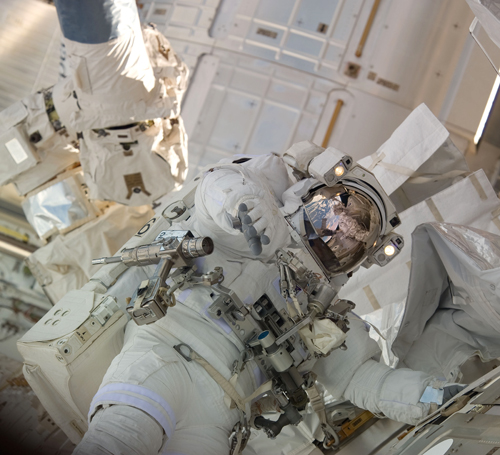
Four other near collisions were avoided during the same time period because NASA controllers had sufficient warning to actually move the ISS out of the way of oncoming projectiles.
In August 2012, the upper stage of a Russian launch vehicle failed, leaving a partially-loaded rocket body stranded in an elliptical LEO orbit, reported by NASA’s Orbital Debris Quarterly News (ODQN) in its October 2012 issue. The two spacecraft it was carrying, Telkom 3 and Express MD2, were also stranded in the same orbit. The rocket body, called Briz-M, was part of the long-standing Russian Proton rocket used in Russian space launches for decades. But in two similar previous incidents, the same upper rocket stages on the same kind of rocket failed, in 2007 and in 2010. The ODQN reported that about 100 large pieces of debris from each of these failures have been catalogued, but “a much larger number of hazardous debris are [sic] believed to stretch from 300 to nearly 29,000 km.”26
Follow the junkNicholas Johnson, NASA’s Chief Scientist for Space Debris, described the range of space debris in a 2009 media briefing. “Typically, this includes non-functional spacecraft, abandoned launch vehicle stages, mission-related debris, debris which is thrown off intentionally, normally during deployment of the mission, and then fragmentation debris. In fact, the majority of debris in Earth orbit has originated from fragmentations, primarily accidental fragmentations.”27
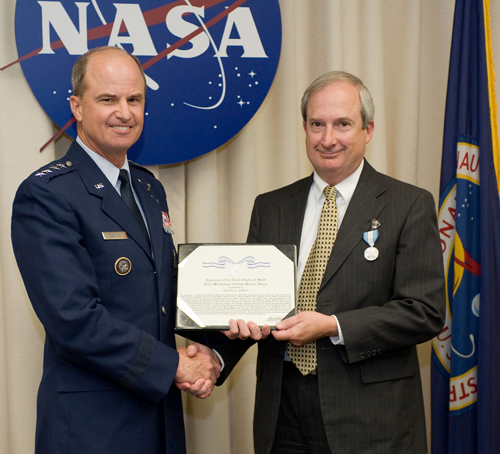
As noted above, debris clouds result from satellite explosions, collisions, accidents and sometimes deliberate targeting. The debris cloud also includes explosions of the upper stages of old launch vehicles left in orbit after their operational life cycles are over or after their satellite payloads are delivered. These upper rocket stages often still contain residual propellants and high pressure fluids.
In addition, sometimes astronauts accidentally drop tools when they’re doing EVAs – ExtraVehicular Activities — or outside work on the station. Those tools float off into their own uncontrollable orbits.
The Space Debris Office of the European Space Agency estimates current launch rates of 60 to 70 spacecraft or satellites every year, and orbital breakups of four or five per year.
The United Nations compiled a comprehensive Technical Report on Space Debris covering the subject in considerable depth, releasing it in 1999.28 It became known as The Rex Report for one of the lead scientists involved in its production, Prof. Dietrich Rex of Technische Universitat Braunschweig – the Technical University of Braunschweig. Prof. Rex was formerly chairman of the Space Debris Advisory Group of the European Space Agency and a member of the International Academy of Astronautics.
The Rex Report provided detailed specifics of a vast range of both exotic and conventional objects that comprise or contribute to the debris field around Earth, many of them mission-related objects:
Approximately 12 percent of the present catalogued space debris population consists of objects discarded during normal satellite deployment and operations. Typical objects in this category are fasteners, yaw and yo-yo weights, nozzle covers, lens caps, multiple payload mechanisms and so forth.
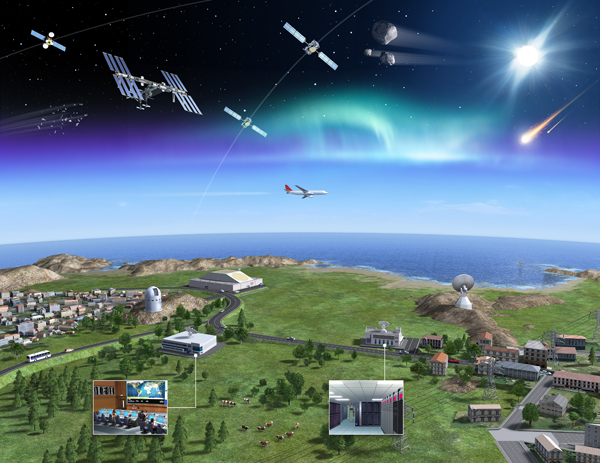
The report said there is also “conventional” debris such as clamp bands and sensor covers, fragments of explosive bolts, space tethers, solid rocket motor effluents, paint, and slag resulting from the burn of solid rocket motors. It went on to say:
The consequences of fragmentations of upper stages and spacecraft constitute approximately 43 per cent of the current identified satellite population and may account for as much as 85 per cent of all space debris larger than 5 cm (about two inches) in diameter….(and) 36 per cent of all resident space object breakups are upper stages or their components that operated successfully but were abandoned after the spacecraft delivery mission was completed. Such incidents have affected a wide range of launch vehicles operated by the United States, the Russian Federation, China and ESA.29
At that time, in 1999, mitigation of space debris could have been accomplished, the report stated, by limiting “orbital lifetimes” of spacecraft, using controlled re-entry manoeuvres or by moving spacecraft to lower orbits. But space even higher than GEO orbit is also used for space debris disposal. “For space objects at higher altitudes, moving vehicles into disposal orbits can also be effective for the foreseeable future,” the report states. “For example, the transfer of geostationary orbit spacecraft to orbits above GEO not only protects operational spacecraft but also reduces the probability of derelict objects colliding with one another and creating debris that might threaten the GEO regime.”30
Scientists seek solutionsNASA’s Orbital Debris Program Office was established in 1979, a year after the publication of Kessler’s “Debris Belt” article. A number of other countries are also involved in tracking space debris and working towards some kind of identification and solution. Russia, China, Japan, France and the European Space Agency all have orbital debris programs and all have issued orbital debris mitigation guidelines.
A primary international organization was launched in 1993 called the Inter-Agency Space Debris Co-ordination Committee (IADC), which according to its website is “an international governmental forum for the worldwide coordination of activities related to the issues of man-made and natural debris in space.”31
Its website states: “The primary purposes of the IADC are to exchange information on space debris research activities between member space agencies, to facilitate opportunities for cooperation in space debris research, to review the progress of ongoing cooperative activities and to identify debris mitigation options.”
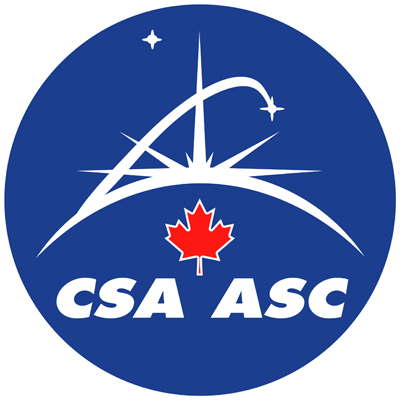
In November 2010, the Canadian Space Agency joined IADC as a full member, which is defined as “national or international space agencies that perform space activities and actively contribute to space debris research.” Member agencies include Italy’s ASI (Agenzia Spaziale Italiana), France’s CNES (Centre National d'Etudes Spatiales), China’s CNSA (China National Space Administration), Germany’s DLR (German Aerospace Center), ESA (European Space Agency), India’s ISRO (Indian Space Research Organisation), Japan’s JAXA (Japan Aerospace Exploration Agency), America’s NASA (National Aeronautics and Space Administration), Ukraine’s NSAU (National Space Agency of Ukraine), Russia’s ROSCOSMOS (Russian Federal Space Agency) and Britain’s UK Space (UK Space Agency).
The formation of the IADC is an interesting story, described very well in NASA’s Orbital Debris Quarterly News:
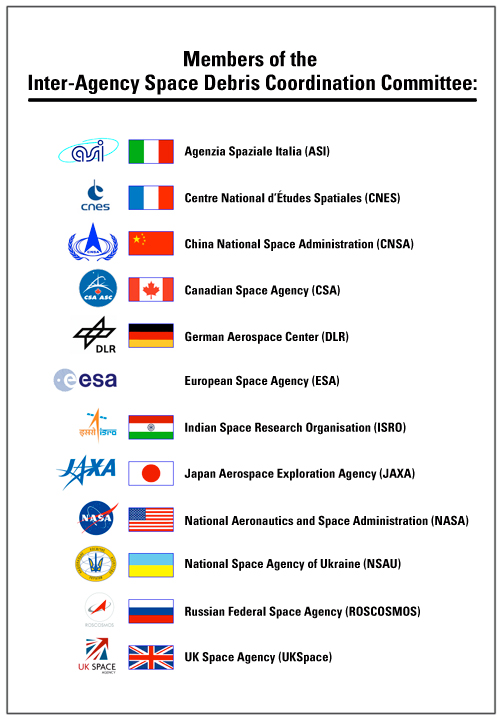
Good things often arise from unfortunate events, and the IADC is a case in point. On 26 November 1986, an Ariane 1 second stage spontaneously exploded in Low Earth Orbit, creating the largest orbital debris cloud to that date. A total of 492 large debris was eventually catalogued from the fragmentation, although fortunately only 32 still remain in orbit today. This significant space event led NASA’s Orbital Debris Program Office to host an international conference on the breakup of launch vehicle upper stages the following May and led ESA to establish a Space Debris Working Group…. NASA orbital debris experts visited both the Soviet Union and Japan by the end of 1989 and established separate orbital debris working groups with the two nations.32
Subsequently, a number of other issues and countries were identified and the group was officially formed in Moscow in 1993. Although not a part of the United Nations, since 1997 the IADC normally provides a special technical presentation before the annual meeting of the
Scientific and Technical Subcommittee of the UN Committee on the Peaceful Uses of Outer Space (COPUOS). The IADC space debris mitigation guidelines were used as the foundation for the development of the UN COPUOS space debris mitigation guidelines.33
Since its inception, IADC has conducted annual meetings on measurement, modelling protection and mitigation, reported and tracked by the ESA Space Debris Office. In the short term, preventing in-orbit explosions is the most effective means to reduce debris, according to ESA, but in the long term, debris has to be removed from orbit.
In 2010, the U.S. National Research Council convened an ad hoc Committee for the Assessment of NASA’s Orbital Debris Programs, and brought Donald Kessler, the retired NASA scientist whose seminal research in 1979 remains a touchstone of the field, out of retirement to chair the committee.34
Every four years, the European Space Agency conducts the European Conference on Space Debris. The International Astronautical Congress (IAC) and the Committee on Space Research (COSPAR) also hold dedicated sessions and conferences on space debris research.
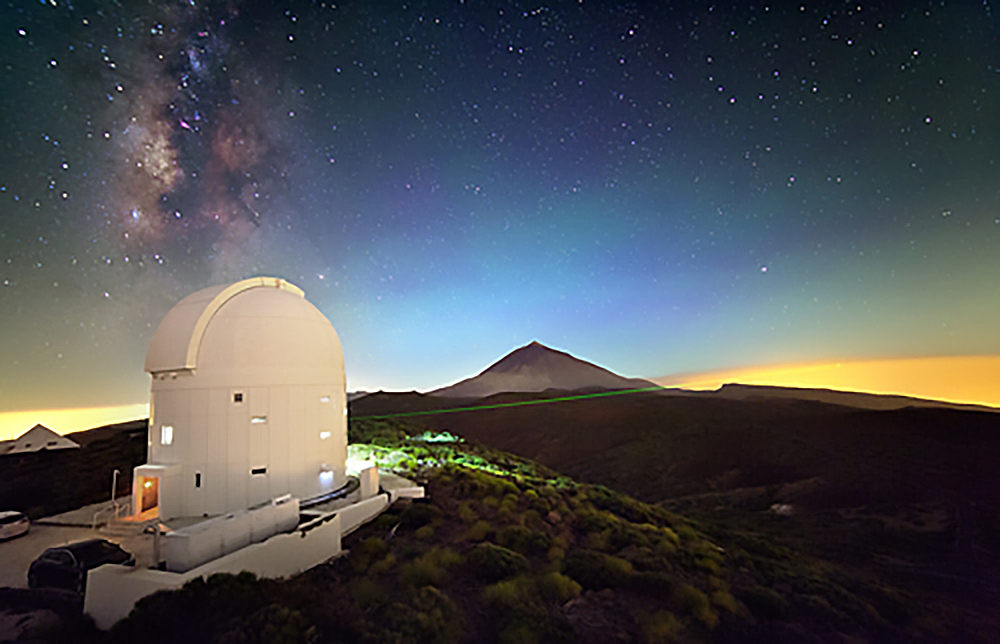
But while the scientific organizations increasingly focus their efforts on identification, mitigation and removal of space junk, the problems continue to increase.
NASA’s Nicholas Johnson wrote in 2006: “The current debris population in the LEO region has reached the point where the environment is unstable and collisions will become the most dominant debris-generating mechanism in the future.”35 This was prior to the 2009 Kosmos-Iridium collision.
Kessler’s cascade effect of multiplying debris in orbit is becomingly increasingly more probable. In 2011, Jon Cartwright wrote in Nature News, “Space analysts are particularly concerned about the possible onset of the Kessler syndrome, when enough debris is present to make collisions so likely there would be an avalanche effect that would leave the Earth's orbit uninhabitable for satellites.”36
Enter the DragonIn addition to the current constellation of satellites in orbit and various space vehicles from a number of countries continuing to launch into orbit, a new phase of private space exploration has begun. This new phase includes commercial exploration, supply vehicles and space tourism.
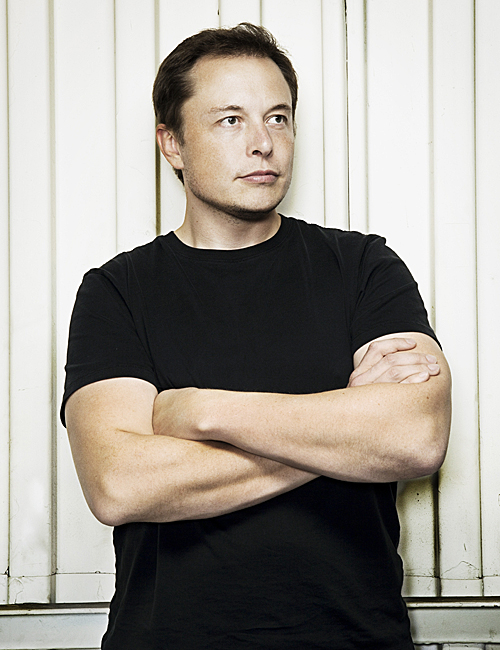
When NASA decided to retire the aging Space Shuttle fleet and not replace it with a contemporary or even more advanced spacecraft, the organization made the decision to allow private sector entry into its Space Station Research Program. In May 2012, the first private spacecraft docked with the International Space Station, delivering supplies to the astronauts and returning to Earth with scientific experiments and equipment. This first private spacecraft to visit the International Space Station was named Dragon. Dragon and the rocket that carried it into space, called Falcon 9, were built by a new private space company, Space Exploration Technologies — SpaceX for short.
Private, commercial space exploration was thought to be impossible because of the costs of developing and building spacecraft. However, the founder of SpaceX is Elon Musk, co-founder of the huge Internet payment service PayPal and, subsequently, founder of Tesla Motors, the first highly successful company to manufacture an all-electric, high-end sports car, comparable to Ferrari or Lamborghini. Tesla Motors is moving into design and manufacture of mid-size, affordable electric cars. SpaceX has a $1.6 billion contract with NASA for 12 Dragon launches and its future plans include development of a Dragon-based space platform for technology demonstrations, scientific experiments and instrument testing.
Virgin for hireOn the space tourism front, Virgin Records founder and serial entrepreneur Richard Branson launched Virgin Galactic. Branson’s other successful ventures have included Virgin Mobile, an international cell phone company, and Virgin Airlines. Virgin Galactic is referred to as the company’s “spaceline”, complementing Virgin Airlines. In June 2012, Virgin Galactic completed its first test glide flight of its SpaceShipTwo (SS2), a sub-orbital passenger-carrying spacecraft.

Branson is building “Spaceport America” in New Mexico as the launch site for his $200,000 zero-gravity space tours. SS2 is designed for six passengers and two pilots at a time for space flights which will be hours, not days, long. The company is already selling tickets online and is reported to have more than 500 passengers anticipating their first space flight. Virgin Galactic is also preparing to enter the launch-to-orbit industry, with the development of its air-launched “LauncherOne” rocket, designed to deliver small satellites directly into orbit.
Not only is space getting increasingly crowded with satellites and space debris, space tourism, together with beyond-orbit exploration of the galaxy, will increase traffic even more. Scientific focus is increasingly turning towards not only theoretical collision probabilities, but ways to reduce the collisions and cut back or eliminate some of the space debris.
Harpooning the junk“The most effective short-term means of reducing the space debris growth rate is through the prevention of in-orbit explosions,” says the European Space Agency. “The only effective long-term means of stabilising the space debris environment at a safe level is through the removal of mass from regions with high object densities.”
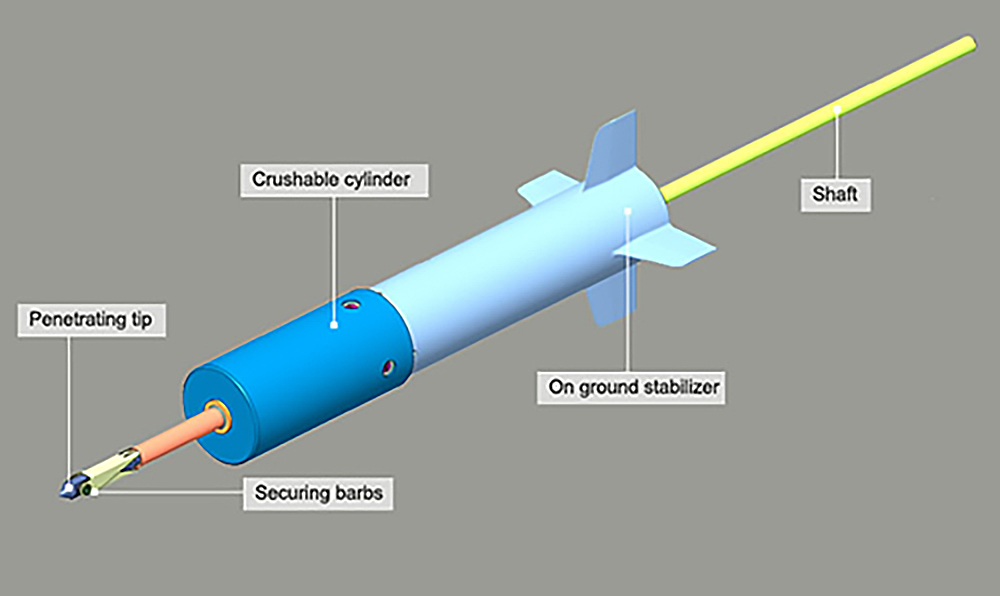
Kessler believed in the 1970s that the only ways to eliminate space debris were retrieval of space junk and atmospheric re-entry — forcing debris down into Earth’s atmosphere where it would hopefully disintegrate or burn up on re-entry.
ESA’s proposal of “removal of mass” from orbital areas crowded with space junk has led to a number of creative and science-fiction-type solutions. British scientists from Astrium UK, a European space technology and satellite company, are working on what they call a “space harpoon” mounted on a “chaser satellite” which would target large pieces of space debris, firing the harpoon from close range into the errant space junk. They would then use a tethered propulsion pack to alter the junk’s orbit down towards Earth, where it would burn up in the atmosphere.
Moving decommissioned spacecraft into a higher orbit is another method for removing problem spacecraft from useful orbital elevations. The “disposal orbit” referred to in the UN report has other names in the scientific community, including “supersynchronous orbit”, i.e. considerably higher than GEO, it is also known as the “junk orbit” and the “graveyard orbit”. But, of course, there may quite possibly be a time limit on the graveyard orbit. It only moves decommissioned spacecraft further into space, which is exactly the area new exploration spacecraft, such as the Mars Rover, must traverse.
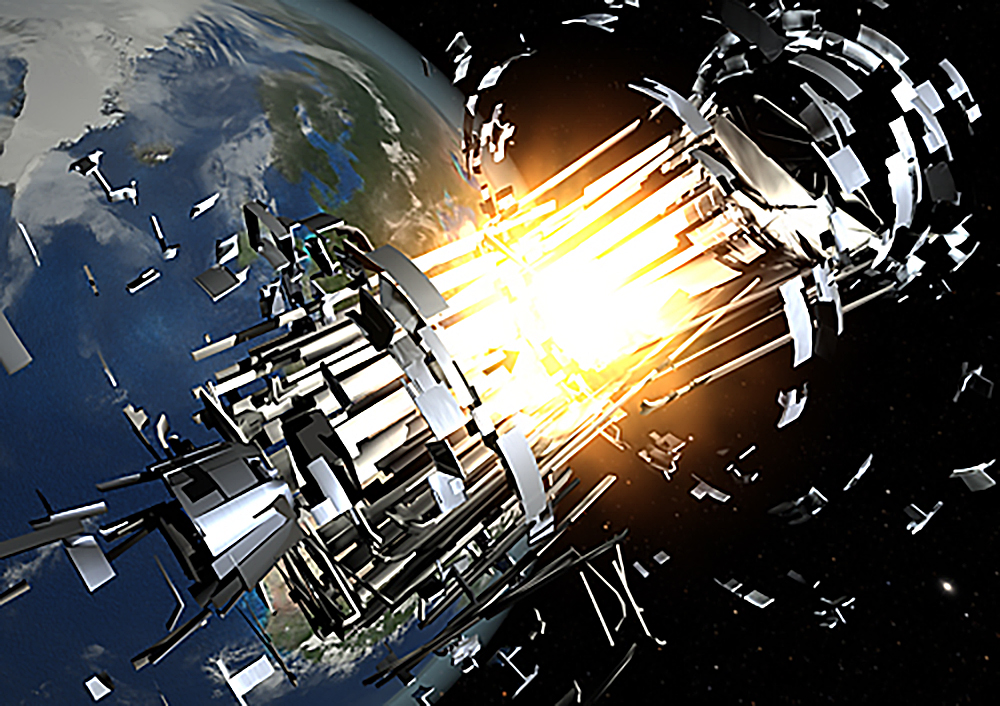
Another novel solution has emerged from DARPA, the U.S. Defense Advanced Research Project Agency, the organization that did, in fact, invent the Internet. The proposal involves the construction of the Electrodynamic Debris Eliminator (EDDE), a space vehicle equipped with about 200 nets which the vehicle would use to capture pieces of space debris larger than two kilograms, primarily in LEO. The plan, still in the theoretical stage, is for 12 EDDE vehicles which could clean up some 2,500 major debris pieces within about seven years. The EDDE vehicles could either direct the space junk into specific areas of Earth’s atmosphere where there would be no significant harm on landing, or, even more useful, collect space junk for possible re-use or recycling — in effect, orbital mining.
Grasping forlaser beamsThere are other possible solutions under consideration, from a laser beam that targets tiny pieces of space junk — a difficult task and one that could end up missing its intended target and hitting an unintended one — to a tiny, dedicated and relatively inexpensive spacecraft designed to capture single pieces of space junk and then deliberately de-orbit into Earth’s atmosphere.
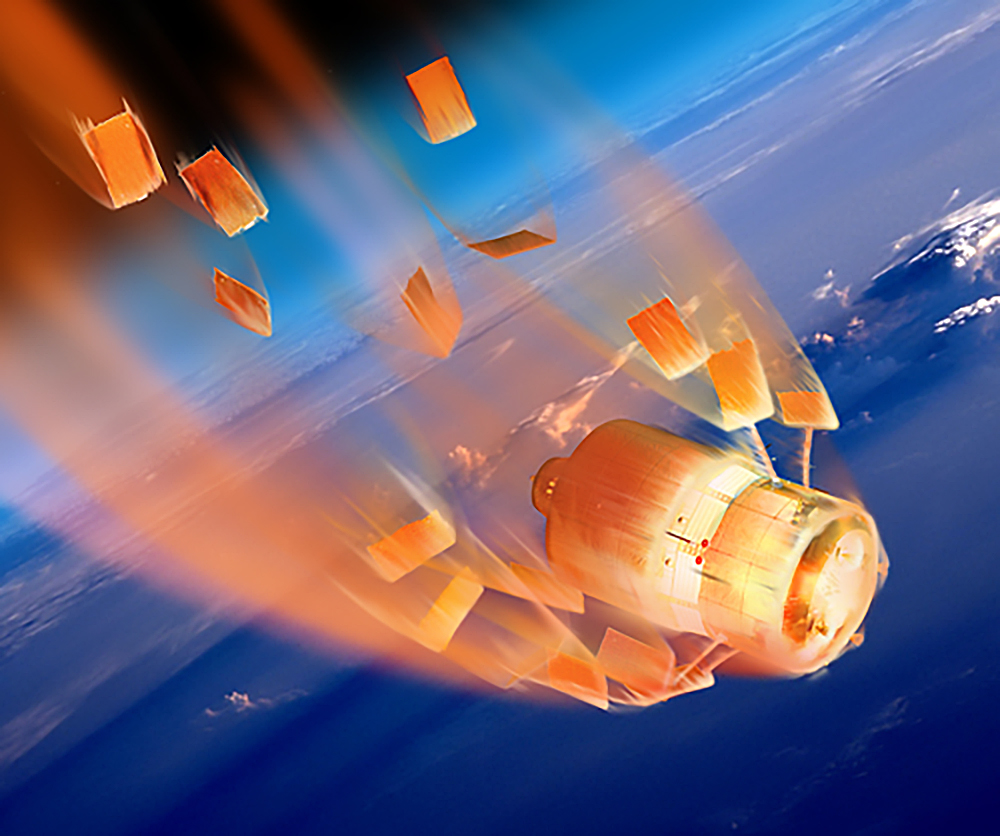
But the varying sizes of space debris necessitate vastly different approaches. NASA’s Nicholas Johnson described the sizes and the issues with each in the 2009 media briefing.
“We normally divide collision risk into three categories, dependent upon the size of the object,” Johnson said. “If the object is 10 centimetres or larger, then it is normally tracked by the U.S. Space Surveillance Network, and we can discreetly determine when a close approach may occur and, if necessary, conduct a collision avoidance manoeuvre, just simply to get out of the way.” For example, NASA will physically move the International Space Station out of the path of approaching debris.
The worst category of debris objects is between one and 10 centimetres, Johnson continued, because these pieces are large enough to damage spacecraft, but too small to be tracked. Debris that small can still cause catastrophic damage to the International Space Station, concluded the Final Report of the International Space Station Independent Safety Task Force.37 For space bits smaller than one centimetre, debris shields are an option for most spacecraft. The International Space Station has over 200 individual debris shields on its exterior, covering most of the spacecraft.
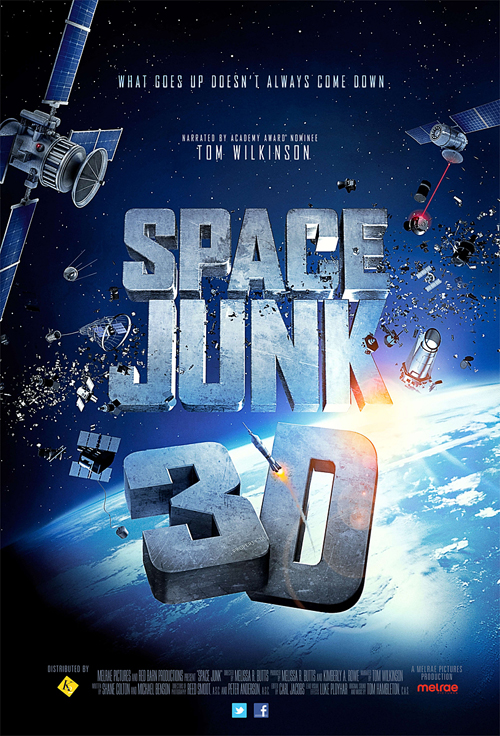
While scientists struggle to find solutions to the space junk threat, educators and media are trying to sensitize the population, especially teenagers and young adults, as to the problems we face. Melrae Pictures, a U.S. award-winning creator of 3D and 2D entertainment, released a documentary in 2012 called Space Junk 3D, which tells the story of how overwhelming space debris has brought us to the tipping point, jeopardizing space exploration for future generations.
The film, narrated by Academy Award nominee Tom Wilkinson, carries the tagline, “What Goes Up Doesn’t Always Come Down”. It was available in theatres in the U.S. in 2012, but not in Canada. Melrae Pictures has produced a print guide for high school educators who wish to show the film to students as part of their curriculum.
Hopefully, we’ll face this problem and find solutions to it because an inability to deal with our massively increasing garbage — combined with environmental destruction brought about by global warming — may eventually make Earth uninhabitable. While filling our home planet with garbage, we are also messing up this corner of our galaxy. The ultimate irony may be that we could be quarantined on Earth by our own space debris, unable to get off our planet because of all the junk we have dumped into our own galactic neighbourhood.
Editor’s Note: International space scientists use both metric and imperial measurements, which is reflected in our story. In some instances, we have utilized both the metric and imperial systems to illustrate the same example, in the hope of making the figures understandable to as many readers as possible around the world.
1. European Space Agency, Space Debris Office; ‘First-ever in-orbit collision’ 2. NASA Orbital Debris Quarterly News, Vol. 11, Issue 2, April 2007, p. 2: “Chinese Anti-satellite Test Creates Most Severe Orbital Debris Cloud in History” 3. NASA Orbital Debris Program Office online FAQs 4. ‘NASA Tracking Space Junk Ahead of Private Launch to Space Station,’ Tariq Malik, space.com managing editor, October 6, 2012, space.com 5. Area of the Pacific Gyre, NOAA – marinedebris.noaa.gov; depth of the Pacific Gyre - Discover Magazine online, July 8, 2008, ‘The World’s Largest Dump: The Great Pacific Garbage Patch,’ by Thomas M. Kostigen 6. European Space Agency, Space Debris Office 7. NASA Orbital Debris Quarterly Report, Volume 16, Issue 2, April 2012, and Space.com, June 28, 2012 8. United Nations Technical Report on Space, New York, 1999; Space debris mitigation measures: A. Reduction of the debris increase in time: 1. Avoidance of debris generated under normal operation: (a) Mission-related objects 9. Micrometeoroid and Orbital Debris: Impact Damage on Materials and Structures in Space, R.C. Tennyson; Encyclopedia of Aerospace Engineering, December, 2010, John Wiley & Sons Ltd. 10. earthsky.org 11. ‘Model for Predicting Micrometeoroid/Debris Impacts and Damage to Composite Materials’; R.C. Tennyson, 1993 12. ‘Debris and Micrometeoroid Impact Damage on Spacecraft Materials and Structures’, R.C. Tennyson, final report submitted to the Canadian Space Agency, March 31, 1994. 13. Tennyson, R.C., Lecture at University of Toronto on Micrometeoroid and Orbital Debris, 1998 14. ‘Collision Frequency of Artificial Satellites: The Creation of a Debris Belt’, D. J. Kessler and B. G. Cour-Palais, Journal of Geophysical Research, Vol. 83, No. A6, June 1, 1979; p. 2637 15. ‘Collision Frequency of Artificial Satellites: The Creation of a Debris Belt’, D. J. Kessler and B. G. Cour-Palais, Journal of Geophysical Research, Vol. 83, No.A6, June 1, 1979; page 2639 16. ‘Collision Frequency of Artificial Satellites: The Creation of a Debris Belt’, D. J. Kessler and B. G. Cour-Palais, Journal of Geophysical Research, Vol. 83, No. A6, June 1, 1979; p. 2645v 17. ‘Space Debris in the Satellite Orbit’, D. Lavers, Broadcast Dialogue, November, 1999 18. UCSUSA.org homepage; Union of Concerned Scientists, sourced from the UCS Satellite Database, figures as of July, 2012. 19. United Nations Technical Report on Space, New York, 199; Deorbiting and reorbiting of space objects, (a) Mission termination of space systems, Sec. 102 20. Global Positioning System Website, Gps.gov/systems/gps/space 21. Spaceandtech.com 22. Union of Concerned Satellites, Uscusa.org 23. NASA Orbital Debris Quarterly Report, Volume 16, Issue 2, April, 2012 24. NASA Orbital Debris Quarterly Report, Volume 16, Issue 2, April, 2012 25. Nasa.gov/mission_pages – International Space Station – Space Station Assembly 26. NASA Orbital Debris Quarterly News, October, 2012 27. NASA Office of Public Affairs, News Update “Space Debris;” telecon tutorial on space debris for media, April 28, 2009 with Nicholas Johnson, Chief Scientist for Space Debris 28. United Nations Technical Report on Space, New York, 1999 29. United Nations Technical Report on Space, New York, 1999 Space debris mitigation measures: A. Reduction of the debris increase in time: 1. Avoidance of debris generated under normal operation: (a) Mission-related objects 30. United Nations Technical Report on Space, New York, 1999: Deorbiting and reorbiting of space objects, (a) Mission termination of space systems, Sec. 102 31. iadc-online.org 32. NASA Orbital Debris Quarterly, October, 2012 33. NASA Orbital Debris Quarterly, October, 2012 34. U.S. National Research Council, Sites.nationalacademies.org 35. Nicholas Johnson and J.C. Liou, ‘Risks in Space from Orbiting Debris,’ Science 311, 340-341, 2006. 36. Jon Cartwright, Nature News, March 15, 2011; http://www.nature.com/news/2011/110315/full/news.2011.161.html 37. The Final Report of the International Space Station Independent Safety Task Force, February, 2007